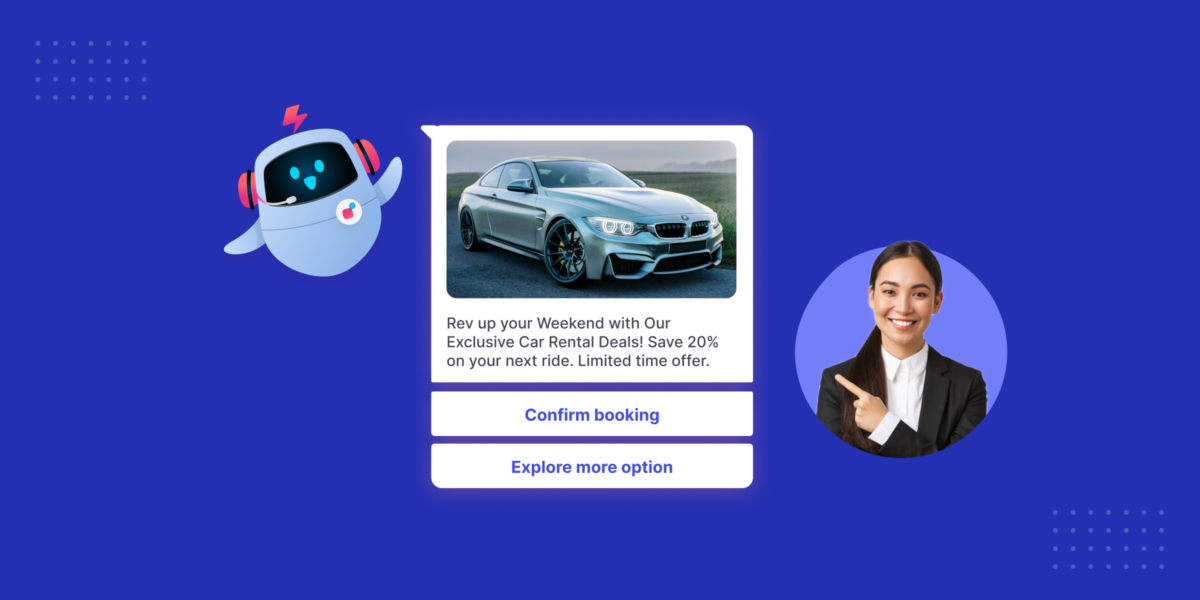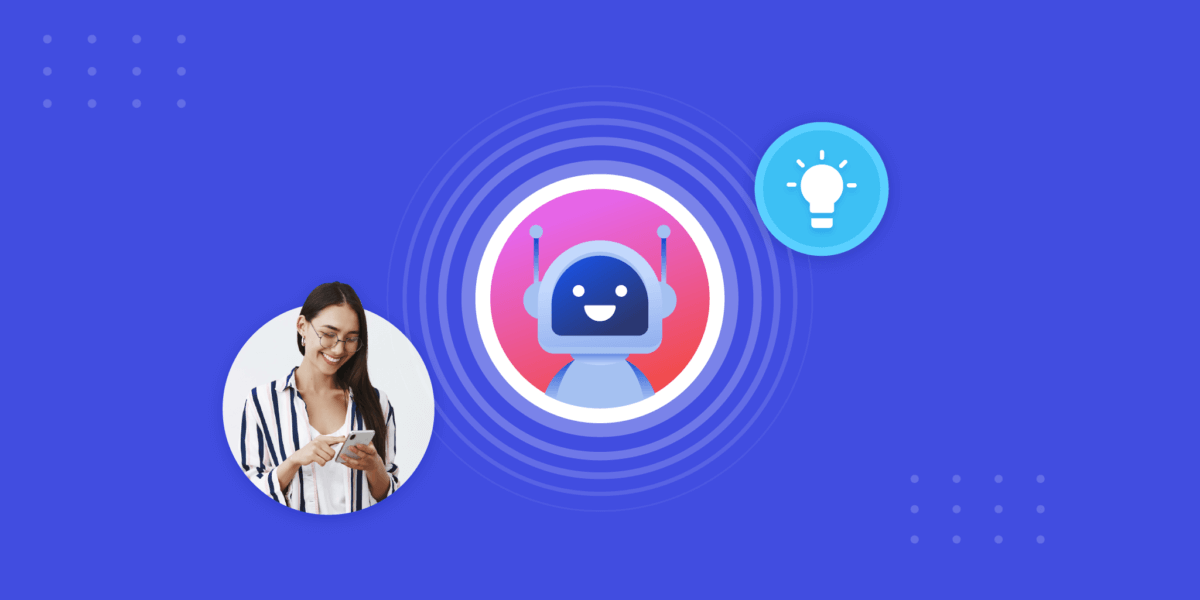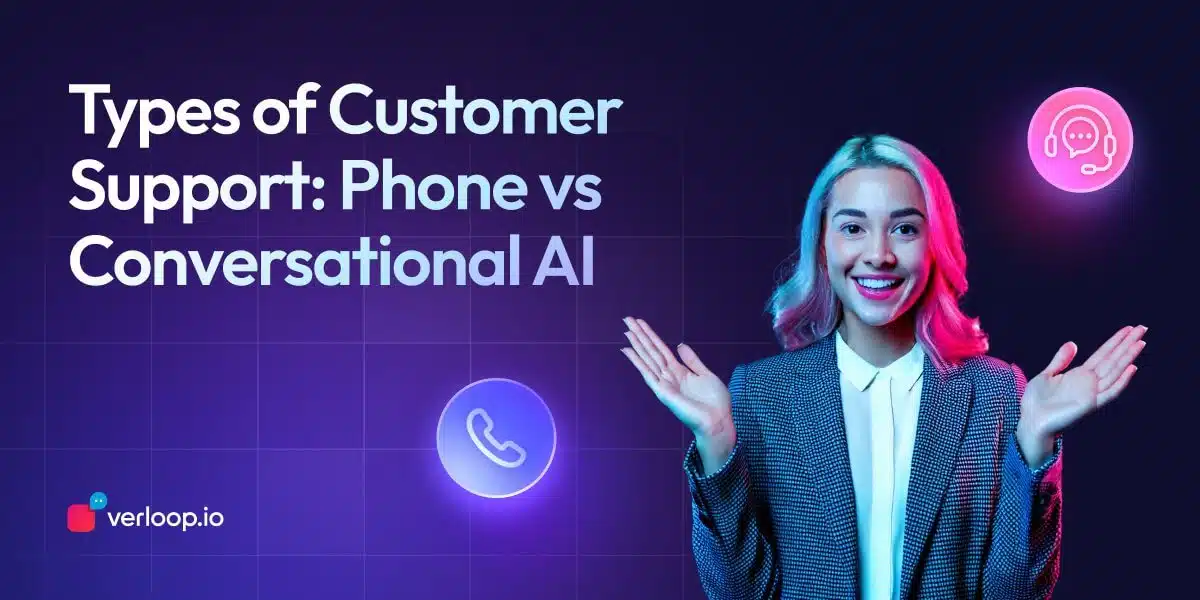Conversational AI in The Automobile Industry
- July 25th, 2025 / 5 Mins read
-
Harshitha Raj

Conversational AI in The Automobile Industry
- July 25th, 2025 / 5 Mins read
-
Harshitha Raj
From dealership floors to in-car infotainment systems, the way customers interact with automotive brands is changing fast, and conversational AI is firmly in the driver’s seat.
Once limited to basic FAQs and scripted voice assistants, AI in the auto industry has shifted gears. Thanks to advancements in generative AI, today’s systems can do far more than just respond—they can understand, personalise, and even anticipate what drivers and car buyers need.
Whether it’s guiding a customer through a test-drive booking, assisting with post-sale support, or helping design a vehicle tailored to their preferences, AI-powered conversations are now shaping the entire automotive experience.
And the numbers reflect this rapid acceleration.
The automotive AI chatbot market is projected to grow from USD 60.48 billion in 2024 to a staggering USD 247.1 billion by 2032, at a CAGR of 19.23%.
Meanwhile, generative AI in automotive—fueled by breakthroughs in design automation, content creation, and customer engagement—is expected to rise from USD 312.46 million in 2022 to USD 2.69 billion by 2032. Closer to home, India’s automotive AI chatbot market is growing even faster, at a CAGR of 28%. With nearly 60% of OEMs already leveraging chatbots for customer service and personalisation, the industry is rapidly embracing AI as a core part of its digital strategy.
What’s driving this growth?
A blend of shifting consumer expectations, increasing operational complexity, and the need for always-on, human-like interaction—whether in showrooms, service centres, or embedded within vehicles themselves.
In this blog, we’ll explore how conversational AI—powered by generative models—is transforming the automotive industry. From improving lead conversion and post-sale support to redefining in-vehicle experiences and accelerating feedback cycles, the road ahead is smarter, faster, and more conversational than ever.
As automakers and industry players integrate AI-driven solutions, they are experiencing a distinct makeover, leading to
- satisfied customers
- accelerated sales
- personalised supply, and
- evolved customer experiences.
Clearly, conversational AI is opening up a new world of possibilities for the automobile industry.
Key Market Trends in Automotive AI Chatbots
The automotive industry is no stranger to transformation. From electric drivetrains to autonomous vehicles, it has repeatedly reinvented itself in response to technological shifts. Now, conversational AI—especially in the form of intelligent chatbots—is steering the next big leap, reshaping how brands interact with buyers, drivers, and service customers.
The automotive AI chatbot market is entering a period of rapid growth, and the trends fuelling this shift reflect broader customer demands and deeper digital integration across the sector.
1. Personalisation as the New Standard
Today’s consumers expect more than answers—they expect relevance.
Chatbots in the automotive space are increasingly being used to provide highly personalised experiences, from recommending car models based on browsing history to sending tailored service reminders based on vehicle usage.
With 60% of Indian OEMs already leveraging AI chatbots for customer service and personalisation, the focus has clearly shifted from reactive support to relationship-driven engagement.
Thanks to NLP advancements, chatbots can now:
-
Understand customer intent in multiple languages and dialects
-
Personalise conversations based on user behaviour and history
-
Recommend products, services, or upgrades based on context
Whether it’s suggesting an EV upgrade or a service plan for a specific car model, AI-powered personalisation is becoming a competitive differentiator.
2. Operational Efficiency Meets Customer Delight
While front-end experience is key, AI chatbots also deliver significant operational efficiencies for dealerships, service centres, and OEMs.
Tasks that once required human intervention—appointment booking, insurance queries, financing information, test drive scheduling—are now being handled autonomously by chatbots. This not only reduces response time and agent load, but also creates a more consistent experience across channels.
Furthermore, cloud-based chatbot platforms are gaining traction, offering:
-
Scalable infrastructure across geographies
-
Lower implementation and maintenance costs
-
Real-time analytics for performance monitoring and optimisation
With auto companies under pressure to do more with less, AI automation is proving both a customer-facing and cost-saving win.
3. Connected Vehicles + Conversational AI = Real-Time Assistance
As vehicles become increasingly connected, AI chatbots are being integrated directly into the in-car ecosystem, creating new forms of proactive engagement.
Imagine a scenario where:
-
A driver is alerted about low tyre pressure via the dashboard
-
The in-car assistant immediately offers to book the nearest service centre
-
Or prompts the driver with preventive maintenance tips based on driving patterns
This kind of real-time, data-driven interaction is becoming possible through the fusion of conversational AI with IoT and telematics systems.
The future isn’t just about asking your car questions. It’s about your car offering help before you even ask.
4. Voice Assistants & Mobile-First Interfaces Gain Ground
The growing popularity of voice-enabled assistants and mobile-first interactions is shaping how customers prefer to engage with brands—especially in emerging markets like India, where mobile is often the primary internet access point.
AI chatbots integrated into WhatsApp, SMS, or dealership apps now:
-
Handle queries in real time through voice or text
-
Enable hands-free interactions for on-the-go drivers
-
Send push notifications for offers, service reminders, or roadside assistance
For younger buyers especially, frictionless, voice-first conversations are becoming the expected norm.
5. From Reactive to Predictive Support
The newest wave of AI chatbots aren’t just responsive—they’re anticipatory.
Through continuous learning, predictive analytics, and pattern recognition, chatbots are now:
-
Suggesting service appointments based on mileage or wear patterns
-
Proactively checking in with customers post-purchase or after test drives
-
Flagging documentation gaps or expired policies before the customer notices
These self-improving systems are reducing dependency on human follow-up and elevating overall customer satisfaction.
6. Cloud-Based Conversational AI Is on the Rise
Companies are increasingly opting for cloud-native chatbot platforms that:
-
Offer faster deployments across regions
-
Allow customisation and updates without manual intervention
-
Ensure high availability and data redundancy
-
Provide granular performance insights at scale
Especially for multi-location dealership networks or large OEMs, cloud infrastructure enables both consistency and agility—two things the automotive customer journey often lacks.
From proactive engagement and real-time support to deeper personalisation and operational efficiency, these trends show that AI chatbots are becoming more than just digital assistants—they’re becoming customer experience engines.
As the market matures and generative AI becomes more deeply embedded, we’ll likely see chatbots evolve from service tools to trusted brand ambassadors—guiding, educating, and supporting customers across every touchpoint of the automotive journey.
Suggest Reading: WhatsApp Chatbot for Insurance
Key Drivers Fueling Growth in the Automotive AI Chatbot Market
The rise of AI-powered chatbots in the automotive industry isn’t a passing trend—it’s a response to deeper shifts in how customers buy, interact with, and experience vehicles. As automakers compete not just on performance but on service, convenience, and digital engagement, conversational AI is emerging as a key differentiator.
Here are the major drivers accelerating adoption across the automotive AI chatbot landscape:
1. The Shift Toward Enhanced, Always-On Customer Experiences
In today’s hyperconnected world, customers expect faster responses, personalised assistance, and seamless interactions—across every touchpoint, from the first inquiry to post-purchase support.
The automotive industry, traditionally reliant on physical showrooms and manual customer service, is now under pressure to match these expectations. This is where AI-powered chatbots are making an immediate impact.
By leveraging natural language processing (NLP) and machine learning (ML), chatbots can:
-
Understand user intent beyond keywords
-
Respond conversationally, across languages and channels
-
Offer tailored assistance—whether it’s product comparisons, finance options, or service bookings
What once required a team of agents is now being handled instantly, at scale—24/7.
And the payoff? Faster resolution times, improved lead conversion, and higher customer satisfaction. The demand for such enhanced experiences is a major force propelling the global automotive AI chatbot market forward.
2. Advancements in AI Are Unlocking More Sophisticated Use Cases
While early chatbots were rule-based and often frustrating, today’s AI assistants are smarter, faster, and continuously learning.
Thanks to breakthroughs in:
-
Deep learning algorithms
-
Pre-trained language models
-
Contextual understanding and memory retention
Modern automotive chatbots can handle far more than basic FAQs. They can guide lease negotiations, predict service needs, and even provide real-time troubleshooting for vehicle issues.
What makes this even more powerful is the feedback loop: with every conversation, ML-based systems improve—adapting to new queries, preferences, and use cases over time.
As AI technology continues to evolve, chatbots are no longer just support tools—they’re becoming digital companions that grow with the customer lifecycle.
3. The Rise of Electric Vehicles (EVs) Is Creating New Engagement Needs
The global shift toward electric mobility is not only transforming vehicle engineering—it’s also changing customer expectations and support requirements.
EV owners have different questions than traditional car buyers. They want to know:
-
Where’s the nearest fast-charging station?
-
How can I monitor battery health remotely?
-
What’s the most efficient driving mode for long-distance travel?
This new layer of product complexity creates an ideal use case for intelligent chatbots that offer real-time, contextual, and proactive support.
For example, an EV chatbot can:
-
Ping the user when their battery hits 20% and offer directions to the nearest charger
-
Help plan road trips with charging stops
-
Remind users about eco-driving techniques or firmware updates
As the EV adoption curve rises, the need for specialised, AI-powered support systems will grow alongside it, driving a whole new segment within the automotive chatbot market.
| Trend | Impact | Opportunity for OEMs & Dealerships |
|---|---|---|
| Rising demand for enhanced customer experience | Customers expect 24/7, personalised, conversational support across channels | Use AI chatbots to automate lead nurturing, test drive bookings, and post-sale CX |
| Advancements in NLP, ML, and Gen AI | Chatbots can handle complex queries and continuously improve via feedback | Build AI copilots for sales, service, and support that learn and scale with usage |
| Growing adoption of electric vehicles (EVs) | EV owners require specialised support (charging, battery, performance tips) | Deploy EV-focused chatbots for proactive alerts, trip planning, and real-time guidance |
Each of these drivers—rising customer expectations, smarter AI capabilities, and the evolving demands of electric mobility—converges on a central idea:
The automotive experience is becoming digital-first and AI-augmented.
As chatbots evolve from reactive assistants to proactive problem-solvers, their role in shaping brand perception, reducing costs, and enabling scalable customer service will only grow stronger.
For automakers and dealerships ready to lead in this space, the opportunity is clear:
Invest in intelligent, conversational experiences or risk being left in the slow lane.
Conversational AI’s Tangible Impact on the Automobile Sector
You might be wondering, beyond manufacturing and driving, how can conversational AI in automobiles contribute to this ever-evolving industry.
The answer is through seamless communication on all fronts.
Conversational AI in automobile improves customer experience and marketing through personalised and data-driven interactions.
Auto companies used to rely on showrooms and phone calls to connect with customers and generate leads. On the other hand, customers had limited options to engage with automobile companies for information or interest in purchasing a car model.
On top of this, the automobile industry has heavily relied on conventional marketing methods to promote their products to customers.
Some of the traditional marketing approaches include:
- Television and Radio Commercials
- Print Advertising
- Billboards and Outdoor Advertising
- Test Drive Events and Auto Shows
Conversational AI has the potential to turn the rides of automobile marketing by providing a more hands-on approach. Here’s how!
- Targeted Marketing through Conversational Ads: Conversational AI enables precise targeting of potential customers through personalised and interactive advertisements.
- Virtual Test Drives: Customers can explore their preferred vehicle by taking simulated test drives, enhancing their buying experience.
- Lead Generation and Qualification: Conversational AI assists in identifying and qualifying leads, streamlining the sales process.
- Data Collection and Insights: Conversational AI gathers valuable data on customer preferences and behaviours, enabling data-driven decision-making.
- Integration with Social Media and Messaging Apps: Automobile companies can easily engage with customers on popular social media platforms and messaging apps.
By leveraging conversational AI’s capabilities, the automobile industry can forge stronger customer bonds and drive better marketing outcomes.
We discuss more about this below!
Suggested Reading: 11 Industries Leveraging The Power Of Chatbot Applications To Grow Their Business!
Leveraging Conversational AI in Automobile: Use Cases
Automobile companies are embracing Conversational AI technology to catch up and meet the changing needs of their customers.
By streamlining communication and reducing wait times, Conversational AI enhances customer satisfaction, establishing auto companies as leaders in customer-centric service.
The following are a few ways to leverage Conversational AI for your automobile business. These use cases demonstrate how conversational AI can streamline the entire customer journey, from pre-purchase to ownership and after-sales support.
1. Booking a Test Drive
Conversational AI streamlines the test drive booking process by eliminating the need for customers to visit a dealership or make phone calls.
Through a virtual assistant, potential buyers can engage in a natural conversation, expressing their interest in a specific car model. The AI can then check the dealership’s availability, present available dates and times that align with the customer’s preferences, and secure a confirmed test drive appointment.
As the scheduled date approaches, the AI can send automated reminders, reducing the likelihood of no-shows and enhancing the overall customer experience.
2. Locate a Dealer Nearby
When a customer expresses interest in purchasing a car, conversational AI can use geolocation data to identify the nearest dealerships or service centres.
Upon narrowing down the customer’s current location or preferred area, the AI can provide a list of nearby authorised dealerships, complete with addresses, contact details, and operating hours.
This convenient feature saves customers time and effort in finding a dealership that suits their needs. Furthermore, the AI can offer directions and navigation assistance to guide customers to their chosen dealership seamlessly.
3. Faster and Personalised Customer Service
Traditional IVR systems often lead to customer frustration due to rigid menu options and limited understanding of natural language.
Conversational AI uses natural language processing and machine learning to understand and respond to customer inquiries.
As a result, customers can express their questions or concerns in a more conversational manner, and the AI can provide accurate and relevant responses.
By recognising individual customers based on their profiles and past interactions, conversational AI can offer personalised solutions and recommendations, fostering a more engaging and satisfying customer service experience.
4. Vehicle Configuration and Customisation
Buying a car involves multiple decisions, including choosing the right combination of features, colours, and accessories.
Conversational AI can guide customers through the customisation process, offering interactive and informative conversations about available options.
Customers can interactively explore various colour choices, interior trims, technological features, and additional accessories that suit their preferences.
The AI can also provide visualisations or images to help customers better envision their personalised vehicle. This level of engagement aids in building a deeper connection between the customer and the brand.
5. Real-time Vehicle Information
Through voice or chat interactions, drivers can access real-time information about their vehicle’s status and health.
Conversational AI can connect to the car’s onboard diagnostic system and provide essential data, such as fuel levels, battery charge, tire pressure, and maintenance alerts.
Additionally, the AI can offer insights into the vehicle’s performance, fuel efficiency, and driving patterns, empowering drivers to make informed decisions about their driving habits and vehicle maintenance.
6. User Manuals and FAQs
Instead of searching through physical manuals or navigating complex websites, drivers and owners can easily access vehicle-related information using conversational AI.
By asking questions or describing issues, drivers can receive specific answers and solutions drawn from the vehicle’s user manual and frequently asked questions database.
This feature simplifies troubleshooting common issues, such as warning lights, maintenance procedures, and system functionalities, making it easier for drivers to understand and operate their vehicles effectively.
7. Virtual Showroom Experience
With Conversational AI, customers can immerse themselves in a lifelike virtual environment, exploring different car models, interiors, and features with stunning realism, significantly improving their pre-purchase experience.
This not only allows potential buyers to make informed decisions but also fosters a deeper emotional connection to the products they are considering.
With 3D technology, customers can virtually view vehicles from different angles and even interact with the car’s features, providing an unparalleled and engaging shopping experience.
As a result, your auto business can stand out from the competition and leave a lasting impression on customers, and drive higher satisfaction and increased sales.
Suggest Reading: Your go to guide on conversational AI solutions
Choose Conversational AI for Your Automobile Business Today!
The world of automobiles is undergoing a remarkable transformation, and Conversational AI is at the forefront of this revolution. It is driving the industry towards efficiency, customer-centricity, and innovation.
If you’re eager to shape the industry’s future, look no further than Verloop.io’s cutting-edge AI solutions for your business today!
With our state-of-the-art technology, you can assist website visitors round-the-clock, even during non-business hours when your agents are unavailable. Streamline FAQs about vehicles, share relevant videos and blog posts highlighting current market trends, and offer real-time support in over 15+ languages.
Automate these processes to reduce your agents’ workload and cut operational costs. Embrace the future with Conversational AI and drive your automobile business towards success!
Choose Verloop.io and schedule a demo today!
FAQs on Conversational and Generative AI in the Automotive Industry
1. What is Conversational AI, and how is it used in the automotive sector?
Conversational AI refers to AI-powered systems—like chatbots and voice assistants—that simulate human-like dialogue. In the automotive industry, it’s used for lead qualification, test drive booking, service reminders, post-sale support, financing queries, and even in-car infotainment. It enables 24/7, consistent, and scalable engagement across channels like WhatsApp, dealership websites, mobile apps, and even connected cars.
2. How is Generative AI different from traditional chatbots?
Traditional chatbots rely on predefined rules or decision trees. Generative AI, on the other hand, uses large language models (LLMs) to generate dynamic, context-aware responses. In automotive, this means Gen AI can craft hyper-personalised messages, generate car listings based on user needs, summarise complex documentation, or even create visual car customisations.
3. Can conversational AI really replace human sales or support teams?
Not replace—but enhance. Conversational AI automates repetitive, high-volume tasks (e.g. FAQs, appointment booking, follow-ups), allowing human teams to focus on high-touch interactions like closing deals or managing escalations. It acts more like a co-pilot—increasing efficiency without compromising the human element.
4. What kind of customer engagement tasks can be automated with AI in automotive?
Here are a few examples:
-
Answering product queries and feature comparisons
-
Booking test drives and service appointments
-
Sending payment reminders or insurance renewals
-
Suggesting service packages based on usage data
-
Re-engaging leads that dropped off after inquiry
-
Providing delivery updates and post-sale check-ins
All of this can be done 24/7, across multiple languages and platforms.
5. How accurate are AI tools when handling automotive-specific questions?
Accuracy depends on training data and model configuration. Generic AI tools may struggle with auto-specific terms or regional nuances. That’s why leading providers fine-tune models with dealership, product, and customer data—so the AI understands trims, model years, financing plans, and service packages contextually.
6. How can generative AI help automotive marketing teams?
Gen AI supports marketing by:
-
Generating personalised ad copy or email campaigns
-
Creating custom landing pages for different buyer personas
-
Summarising competitor pricing or feature trends
-
Drafting regionalised, multilingual content at scale
-
Designing “virtual test drives” or brochure content tailored to the buyer’s needs
This accelerates go-to-market and helps teams create more personalised content—without increasing headcount.
7. What kind of ROI can OEMs or dealerships expect from conversational AI?
The ROI comes from multiple vectors:
-
Lead conversion: AI chatbots increase conversion by up to 33%
-
Support deflection: 60–70% of common queries can be resolved without agent intervention
-
Time savings: 85% of users report faster task completion (scheduling, inquiry handling)
-
Revenue lift: Better engagement = higher test drives, upsell of service packages
-
Cost reduction: 15–20% lower operational overhead via automation
8. Is this solution scalable across regions and languages?
Yes. Modern conversational AI platforms support multi-language models, localisation, and channel integration—across website, mobile, WhatsApp, SMS, and more. OEMs and dealership networks can deploy a consistent experience globally while tailoring tone, offers, and language locally.
9. How does conversational AI support electric vehicle (EV) buyers?
EV customers often have more technical questions around charging, battery life, and maintenance. AI chatbots can:
-
Guide users to charging stations
-
Explain charging options (AC vs DC)
-
Offer trip planning support
-
Remind users about battery health checks
-
Educate first-time buyers on EV benefits
10. What security or data privacy measures are in place for AI in auto CX?
Top conversational AI vendors comply with data regulations like GDPR and ISO standards. Data is encrypted, and chat history is anonymised for training. Role-based access, opt-in consent for data sharing, and secure cloud hosting are standard features in enterprise deployments.






